Monthly Archives: April 2013

Candy Cane Coral
Scientific Name: Caulastrea Furcata
Common Name: Candy Cane Coral, Bullseye Coral, Trumpet Coral
Type of Coral: LPS (Large Polyp Stony Coral)
Lighting: Moderate and Moderate to High
Flow: Moderate and Moderate to High
Care Level: Moderate
Temperament: Peaceful to Semi-aggressive
Appearance
Candy Cane Corals will have a base that consists of an exposed calcified skeleton structure. At the end of this structure will be individual fleshy heads (polyps) with a small mouth in the center. The heads can be green, blue, or brown like in color. One of the more common colors is a bright almost neon green. As this coral grows, the heads will split and the skeleton base will branch almost like a tree grows.

Water Conditions
The below link highlights typical water conditions candy cane corals, as with most LPS, will require. As this is a moderately difficult coral to keep, you should ensure your dKH, Cal and Mag levels are maintained at all times with minimal nitrate and phosphate levels. As this coral also has a calcified skeleton, it will consume calcium from your water. In set-ups with a good amount of LPS corals, it is not uncommon to have to dose dKH and Cal in order to keep the water parameters in line. With only a few LPS corals, a good water change schedule may be enough to maintain your parameters. In addition to the article in the below link, this coral can also benefit from maintaining strontium levels if you do not have a good water change routine using a very good quality salt.
https://www.reefaquarium.com/2013/the-basics-of-marine-aquarium-water-parameters/
General Information
Candy cane corals, as with all other LPS corals, should be added to mature aquariums. However, I have found candy cane corals to be among the easier of the LPS corals to keep. Provided all their requirements are met, that can grow to a colony size bigger than your average basket ball within a few short years. Unless you are planning to move or frag your candy cane coral, you should give it as much as 30 inches of space in your tank.
The candy cane coral will release sweeper / feeder tentacles from its heads to collect food. This will mostly happen when the tanks lights are off. These tentacles can also sting and damage or kill other corals within reach, which is how the candy cane coral will defend itself. What makes the candy cane coral more peaceful than most LPS coral is that its sweeper tentacles are much shorter in comparison only measuring a few inches in length.
Although the candy cane coral will get what it needs from the lighting in your tank, it can also benefit from micro plankton or manual feeding of small pcs of meaty foods placed directly on the mouths at the center of each head. Although manual feedings are not required, it will help to accelerate growth.
As with all corals, the exterior slime coating can be a skin irritant or even highly toxic to humans so please, handle all corals with care. I would recommend wearing rubber gloves whenever you handle corals
Fragging
Frogspawn corals can be fragged with very good success.

Star Polyps
Scientific Name: Briareum sp (used to be classified as Clavularia viridis)
Common Name: Star Polyps.
Type of Coral: Softie
Lighting: Moderate and Moderate to Low
Flow: Moderate and Moderate to Low
Care Level: Easy
Temperament: Peaceful
Appearance
Star Polyps are a smaller coral having a height of about ½ to 1 inch and a head size of about ¼ to ½ inch. The heads of these corals can completely retract into the base making it look like a think purple coating on your rocks. Green and pink are the more common color to find this coral in. I have read they can be found in other colors, but I have only seen them in green and pink.


Water Conditions
The below link highlights typical water conditions star polyps will require. I have had the best luck when they were kept in water with 1 to 2 ppm of nitrate when lighting and flow requirements were met and all other water parameters in line as described in the below link.
https://www.reefaquarium.com/2013/the-basics-of-marine-aquarium-water-parameters/
General Information
Star polyps are colonial type corals, meaning they form a colony of many individual polyps all connected together. As they do not have a calcified skeleton structure, they can be more tolerant of swings in the alkalinity, calcium, and magnesium when compared to other corals. However, they will not be very tolerant to swings in pH, Temp, or salinity which is no different than any other coral or fish..
Star polyps are a very hardy soft coral placing them amount the easier to keep corals and making them an excellent choice as corals for beginners. They have also been known to grow very fast, almost like an invasive coral. These corals can grow on your rocks, on the substrate, and on the glass of your aquarium. They grow almost like a carpet of small polyps. Star polyps are also the least aggressive when it comes to defensive abilities. They can quite frequently become damaged and even start losing heads when they fall victim to another coral’s sting or exposed to those toxins.
As with all corals, the exterior slime coating can be a skin irritant or even highly toxic to humans so please, handle all corals with care. I would recommend wearing rubber glove whenever you handle corals
Fragging
Star polyps can be easily fragged with very high success
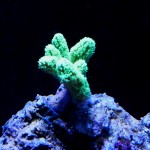
Horn Coral
Scientific Name: Hydnophora SP
Common Name:, Horn Coral, Hydno Coral, Velvet Horn Coral
Type of Coral: SPS (Small Polyp Stony Coral)
Lighting: High
Flow: High
Care Level: Moderate to Difficult
Temperament: Semi-aggressive to aggressive
Appearance
This is a branching SPS coral, as with many other commonly found SPS corals. It can range in color from a brown or cream color to a bright neon green color. The surface of the coral will be covered in very short than thick polyps almost giving it an appearance of being covered in “fur”.
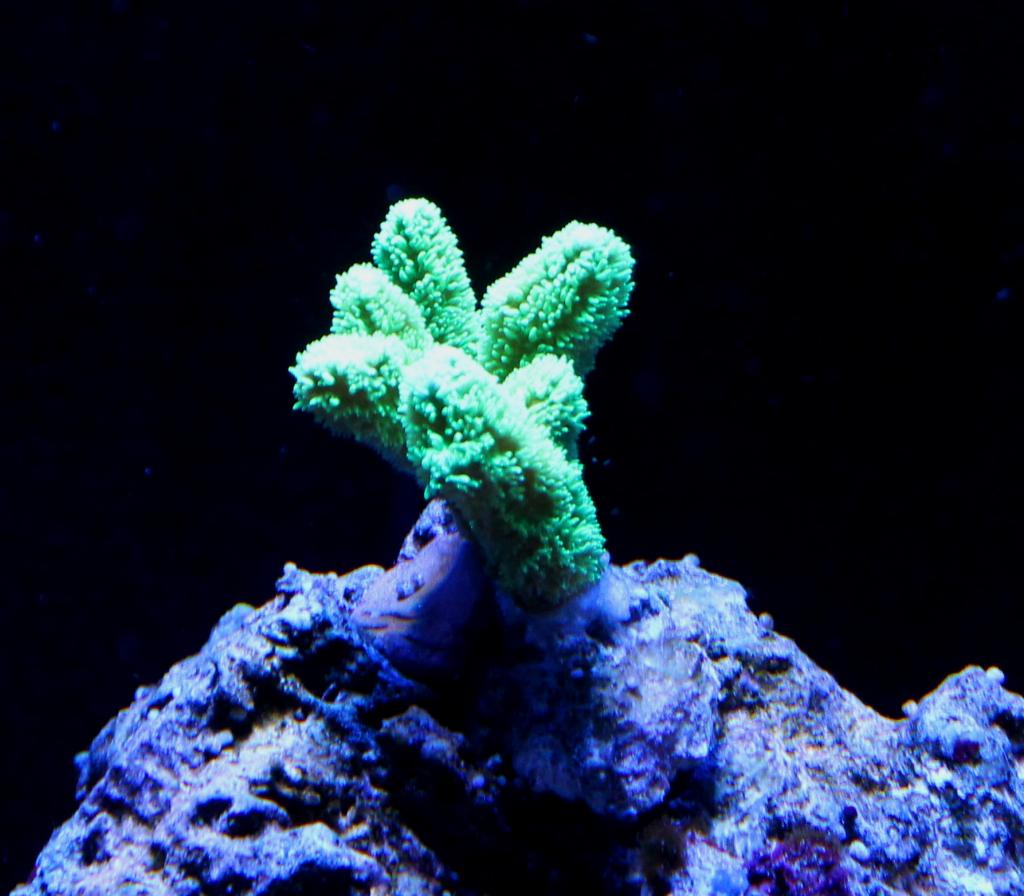
Water Conditions
The below link highlights typical water conditions horn corals, as with most SPS, will require. As this is a moderately difficult to very difficult coral to keep, you should ensure your dKH, Cal and Mag levels are maintained at all times with nitrate and phosphate levels almost undetectable by very good quality test kits. This coral will not tolerate changes in water chemistry very well at all. As this coral also has a calcified skeleton, it will consume calcium from your water. In set-ups with a good amount of SPS corals, it is not uncommon to have to dose dKH and Cal in order to keep the water parameters in line.
https://www.reefaquarium.com/2013/the-basics-of-marine-aquarium-water-parameters/
General Information
Horn corals as with all other SPS corals, should only be added to mature aquariums. Provided all their requirements are met, they can grow very large to about 12 inches. Horn corals typically do best when placed on top of rocks, closer to the aquarium lighting and in areas of higher flow. When provided with the correct conditions, they will grow very fast in an aquarium.
The horn coral can be a somewhat aggressive SPS coral. It will sting other corals close by. The horn coral would require a distance of around 3 to 4 inches from other corals
Generally speaking, SPS corals can also benefit from the occasional feeding micro-plankton designed for filter feeders
Fragging
As with all SPS, they can be fragged with very good success assuming the environmental conditions in the aquarium are suited to SPS corals

Hammer Corals
Scientific Name: Euphyilla Parancora
Common Name: Hammer Coral
Type of Coral: LPS (Large Polyp Stony Coral)
Lighting: Moderate and Moderate to High
Flow: Moderate and Moderate to High
Care Level: Moderate
Temperament: Semi-aggressive to Aggressive
Appearance
Hammer corals will have a base that consists of an exposed calcified skeleton structure. At the end of this structure will be individual fleshy heads with polyps on it. The tips of the polyps will typically be a lighter color as compared with the rest of the polyp. The heads can be a within a range of colors ranging from green, pink gold, and brown As this coral grows, the heads will split and the skeleton base will branch almost like a tree grows. The polyps on the heads of this coral will look almost like the head of a hammer which is where its common name originated from. These corals can sometimes be mistaken for a Torch coral or a Frogspawn Coral. The appearance of the polyps on the heads will allow you to properly identify a hammer coral.


Water Conditions
The below link highlights typical water conditions hammer corals, as with most LPS, will require. As this is a moderately difficult coral to keep, you should ensure your dKH, Cal and Mag levels are maintained at all times with minimal nitrate and phosphate levels. As this coral also has a calcified skeleton, it will consume calcium from your water. In set-ups with a good amount of LPS corals, it is not uncommon to have to dose dKH and Cal in order to keep the water parameters in line. With only a few LPS corals, a good water change schedule may be enough to maintain your parameters. In addition to the article in the below link, this coral can also benefit from maintaining strontium levels if you do not have a good water change routine using a very good quality salt.
https://www.reefaquarium.com/2013/the-basics-of-marine-aquarium-water-parameters/
General Information
Hammer corals, as with all other LPS corals, should be added to mature aquariums. Provided all their requirements are met, they can grow to a colony about the size of your average basket ball within a few short years. Unless you are planning to move or frag your hammer coral, you should give it as much as 30 inches of space in your tank.
The hammer coral will release long sweeper / feeder tentacles from its heads to collect food. This will mostly happen when the tanks lights are off. These tentacles can also sting and damage or kill other corals within reach, which is how the hammer coral will defend itself. This is what makes the hammer more of an aggressive coral as the tentacles can extend as much as 6 to 7 inches beyond the heads.
Although the hammer coral will get what it needs from the lighting in your tank, it can also benefit from micro plankton or manual feeding of small pcs of meaty foods placed directly on the mouths at the center of each head. Even though manual feedings are not required, it will help to accelerate growth.
Clownfish have also been known to host in hammer corals in aquariums that do not have anemones. Although this will not harm the clownfish, this can sometimes stress the coral to the point where some of its heads could die off.
As with all corals, the exterior slime coating can be a skin irritant or even highly toxic to humans so please, handle all corals with care. I would recommend wearing rubber gloves whenever you handle corals
Fragging
Hammer corals can be fragged with very good success.

Plate Corals
Scientific Name: Fungia Repanda
Common Name: Plate Coral, Fungia Plate Coral,
Type of Coral: LPS (Large Polyp Stony Coral)
Lighting: Moderate
Flow: Low/Moderate to Moderate
Care Level: Moderate
Temperament: Semi-aggressive to Aggressive
Appearance
As the name suggests, the plate coral is shape almost like a plate, with a round and somewhat flat body which raises a little in the center where the mouth is. It is also covered with short little tentacles which can typically range in length from 1/8 to ¾ of an inch. They can also come in a very wide range of colors from brownish colors to bright yellows, reds, blues and oranges.


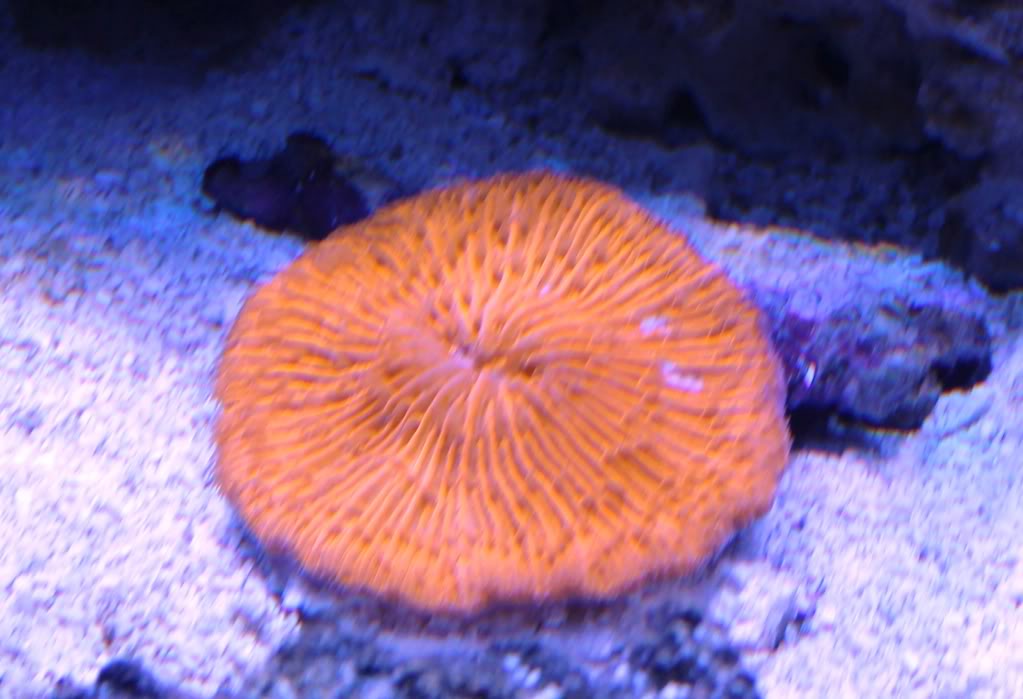
Water Conditions
The below link highlights typical water conditions plate corals, as with most LPS, will require. As this is a moderately difficult coral to keep, you should ensure your dKH, Cal and Mag levels are maintained at all times with minimal nitrate and phosphate levels. As this coral also has a calcified skeleton, it will consume calcium from your water. In set-ups with a good amount of LPS corals, it is not uncommon to have to dose dKH and Cal in order to keep the water parameters in line. With only a few LPS corals, a good water change schedule may be enough to maintain your parameters.
https://www.reefaquarium.com/2013/the-basics-of-marine-aquarium-water-parameters/
General Information
Plate corals as with all other LPS corals, should be added to mature aquariums. Provided all their requirements are met, they can grow to about 8 inches. Plate corals typically do best when place in a smooth and sandy substrate on the bottom of the aquarium
This can be a somewhat aggressive LPS coral. It will release sweeper tentacles that will extend a few inches beyond its base. They can also over inflate their bodies with water to over twice their normal size allow them to move a little. These two factors would require a distance of around 5 inches from other corals
These corals can benefit from the occasional feeding of meaty foods, or pellet foods meant for corals. I would recommend feeding this coral once every week or two for its best long term health. The below link can explain how to feed these corals in more detail
https://www.reefaquarium.com/2012/feeding-corals/
As with all corals, the exterior slime coating can be a skin irritant or even highly toxic to humans so please, handle all corals with care. I would recommend wearing rubber gloves whenever you handle corals
Fragging
Plate corals should not be fragged.

Brain Coral
Scientific Name: Trachyphyllia Radiata
Common Name:, Brain Coral, Folded Brain Coral
Type of Coral: LPS (Large Polyp Stony Coral)
Lighting: Moderate
Flow: Moderate
Care Level: Moderate
Temperament: Semi-aggressive
Appearance
Brain will typically have irregular but round like shape with the appearance of folded flesh forming ridges and lower spots in the smooth surfaces in between. They can have more than one mouth, but these mouths will always be located in the smooth low spots between the folds. Brain corals will also come in a wide range of colors and can have more than one color on their body. These unique color variations and combinations can make these corals more appealing to many hobbyists.

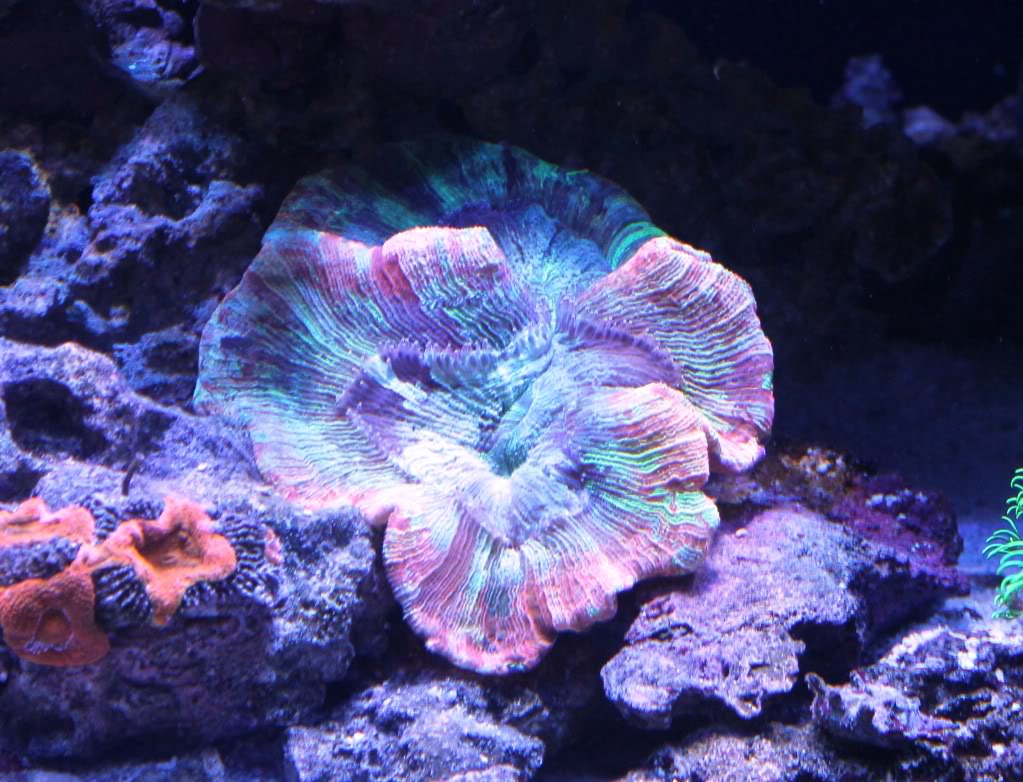
Water Conditions
The below link highlights typical water conditions brain corals, as with most LPS, will require. As this is a moderately difficult coral to keep, you should ensure your dKH, Cal and Mag levels are maintained at all times with minimal nitrate and phosphate levels. As this coral also has a calcified skeleton, it will consume calcium from your water. In set-ups with a good amount of LPS corals, it is not uncommon to have to dose dKH and Cal in order to keep the water parameters in line. With only a few LPS corals, a good water change schedule may be enough to maintain your parameters.
https://www.reefaquarium.com/2013/the-basics-of-marine-aquarium-water-parameters/
General Information
Brain corals as with all other LPS corals, should be added to mature aquariums. Provided all their requirements are met, they can grow to about 6 inches. Brain Corals typically do best when place on a smooth and sandy substrate on the bottom of the aquarium.
The brain coral can be a somewhat aggressive LPS coral. It will release sweeper tentacles that will extend a few inches beyond it’s base. The can also over inflate their body’s a little with water making them a little larger than normal and in some cases, that can allow them to move by a very small amount These two factors would require a distance of around 3 to 4 inches from other corals
These corals can also benefit from the occasional feeding of meaty foods, or pellet foods meant for corals. The below link can explain how to feed these corals in more detail
https://www.reefaquarium.com/2012/feeding-corals/
As with all corals, the exterior slime coating can be a skin irritant or even highly toxic to humans so please, handle all corals with care. I would recommend wearing rubber gloves whenever you handle corals
Fragging
Brain corals should not be fragged.

Long Tentacle Plate Coral
Scientific Name: Heliofungia Actiniformis
Common Name: Long Tentacle Plate Coral, Long Tentacle Fungia Coral, Long tentacle Heliofungia Plate Coral
Type of Coral: LPS (Large Polyp Stony Coral)
Lighting: Moderate
Flow: Low/Moderate to Moderate
Care Level: Moderate
Temperament: Aggressive
Appearance
As the name suggests, the long tentacle plate coral is shaped a lot like a plate, with a round and somewhat flat body which rises a little in the center where the mouth is. It is also covered with long tentacles (with knob like structures on the tips) which can give it an appearance very similar to many anemones like the magnificent anemone for example. Long tentacle plate corals are most commonly brownish to olive green in color.

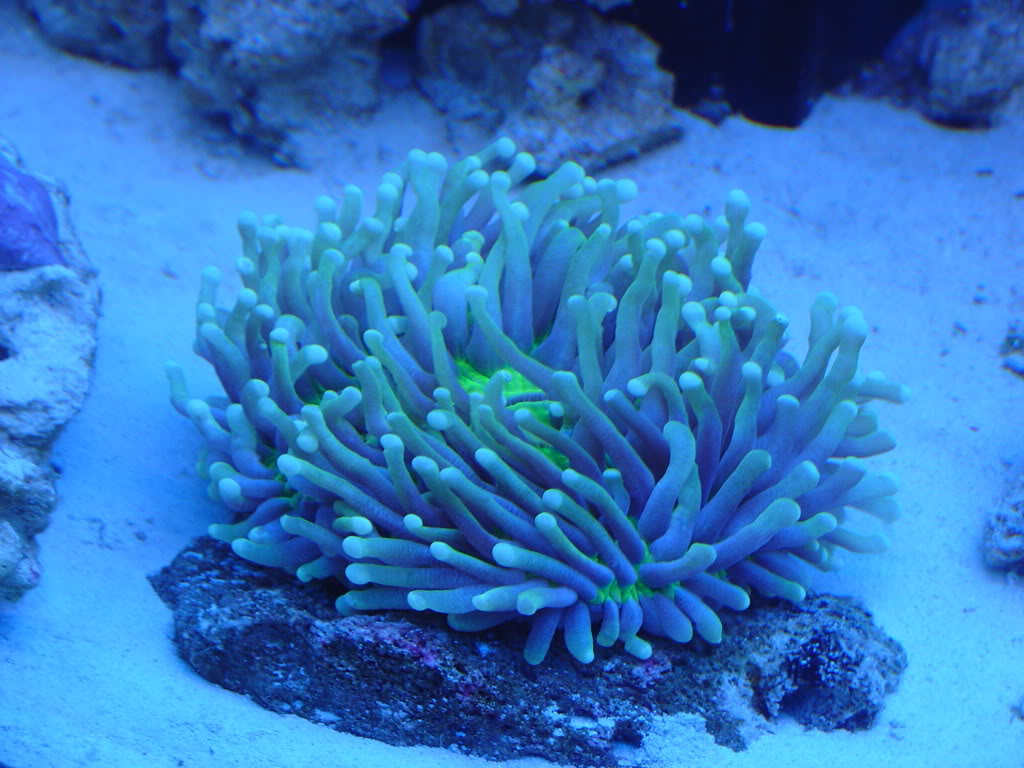
Water Conditions
The below link highlights typical water conditions long tentacle plate corals, just as with most LPS, will require. As this is a moderately difficult coral to keep, you should ensure your dKH, Cal and Mag levels are maintained at all times with minimal nitrate and phosphate levels. As this coral also has a calcified skeleton, it will consume calcium from your water. In set-ups with a good amount of LPS corals, it is not uncommon to have to dose dKH and Cal in order to keep the water parameters in line. With only a few LPS corals, a good water change schedule may be enough to maintain your parameters.
https://www.reefaquarium.com/2013/the-basics-of-marine-aquarium-water-parameters/
General Information
Long tentacle plate corals, as with most other LPS corals, should be added to mature aquariums. Provided all their requirements are met, they can grow to about 8 to 10 inches. Long tentacle plate corals typically do best when place on a smooth and sandy substrate on the bottom of the aquarium
This is a very aggressive LPS coral. It will release long sweeper tentacles that will extend a few inches beyond its base. They can also over inflate their body’s with water to over twice their normal size, which can allow them to move a little. These two factors would require a distance of around 5 inches from other corals.
Clownfish have also been known to host in long tentacle plate corals in aquariums that do not have anemones. Although this will not harm the clownfish, this can sometimes stress the coral to the point where it could become damaged and prone to infections.
These corals can also benefit from the occasional feeding of meaty foods, or pellet food meant for corals. I would always recommend a weekly (or so) feeding for this coral. The below link can explain how to feed these corals in more detail
https://www.reefaquarium.com/2012/feeding-corals/
As with all corals, the exterior slime coating can be a skin irritant or even highly toxic to humans so please, handle all corals with care. I would recommend wearing rubber gloves whenever you handle corals
The below pictures are of one of my long tentacle plate corals inflating itself
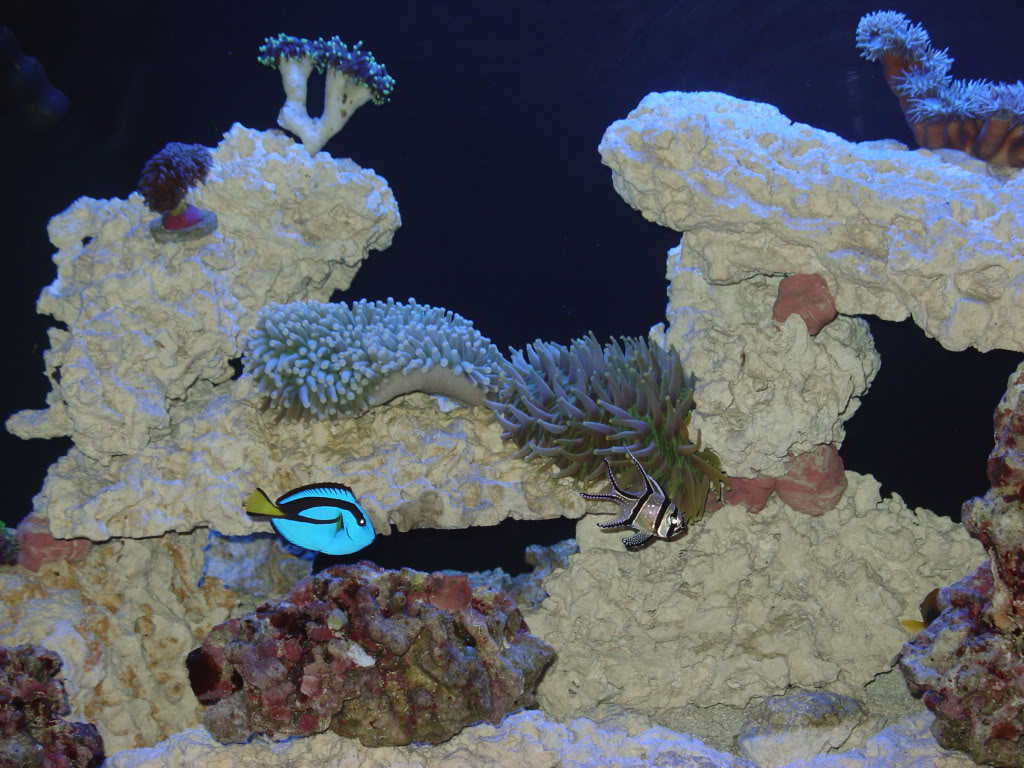


Fragging
Plate corals should not be fragged.

Acro Coral
Scientific Name: Acorpora Humilis
Common Name:, Acorpora, Acro Coral, Humilis Acro Coral
Type of Coral: SPS (Small Polyp Stony Coral)
Lighting: High
Flow: High
Care Level: Very Difficult
Temperament: Peaceful
Appearance
The acro coral is a branching SPS coral, as with many other commonly found SPS corals. The shape this branch coral can take will vary between each individual coral from a bush like structure to having fewer and thicker branches. The thicker branches are more common acro to find. It can range in color from a brown or cream color to a bright neon greens along with a few other less commonly found colors. With over 300 different acro species that are currently documented, it can be a little challenging to properly identify all the different acro corals out there. Most often, the only noticeable difference can be the coloring and growth patterns.
The below arco frag that I bought doubled in size in less than one year



Water Conditions
The below link highlights typical water conditions the acro coral, as with most SPS, will require. As this is a very difficult coral to keep, you should ensure your dKH, Cal and Mag levels are maintained at all times with nitrate and phosphate levels almost undetectable by very good quality test kits. These SPS will be affected by changes in water chemistry so you will need to ensure your parameters are also very stable. As this coral also has a calcified skeleton, it will consume calcium from your water. In set-ups with a good amount of SPS corals, it is not uncommon to have to dose dKH and Cal in order to keep the water parameters in line.
https://www.reefaquarium.com/2013/the-basics-of-marine-aquarium-water-parameters/
General Information
Acro corals as with all other SPS coral, should only be added to mature aquariums. Provided all their requirements are met, they can grow very large to well over 12 inches. The only thing that will limit their growth is the size of your aquarium. In the wild they can grow to become several feet, so you can expect to have to trim back (or frag) your acro at some point. Acro corals typically do best when placed on top of rocks, closer to the aquarium lighting and in areas of higher flow. When provided with the correct conditions, they will grow very fast in an aquarium.
While the acro coral will not sting any other corals, they can still be harmed by other corals stinging them, it would be a good idea to have your acro placed a distance of around 3 to 4 inches from other corals
Generally speaking, SPS corals can also benefit from the occasional feeding micro-plankton designed for filter feeders
Fragging
As with all SPS, they can be fragged with very good success assuming the environmental conditions in the aquarium are suited to SPS corals
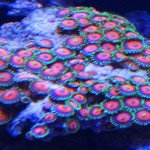
Zoanthid Corals ( Zoas )
Scientific Name: Zoanthus SP
Common Name: Zoanthids, Zoas.
Type of Coral: Softie
Lighting: Moderate and Moderate to Low
Flow: Moderate
Care Level: Easy
Temperament: Peaceful to Semi-aggressive
Appearance
These corals can come in some spectacular range colors and color combinations, among the most amazing colors to be found in any soft coral. Some zoas can have up to three different colors on them: one around the outer edge of the head, one on the head, and a third in the center of the head. Zoas stay fairly small in size (less than 1 inch) but the colony can easily grow and expand.

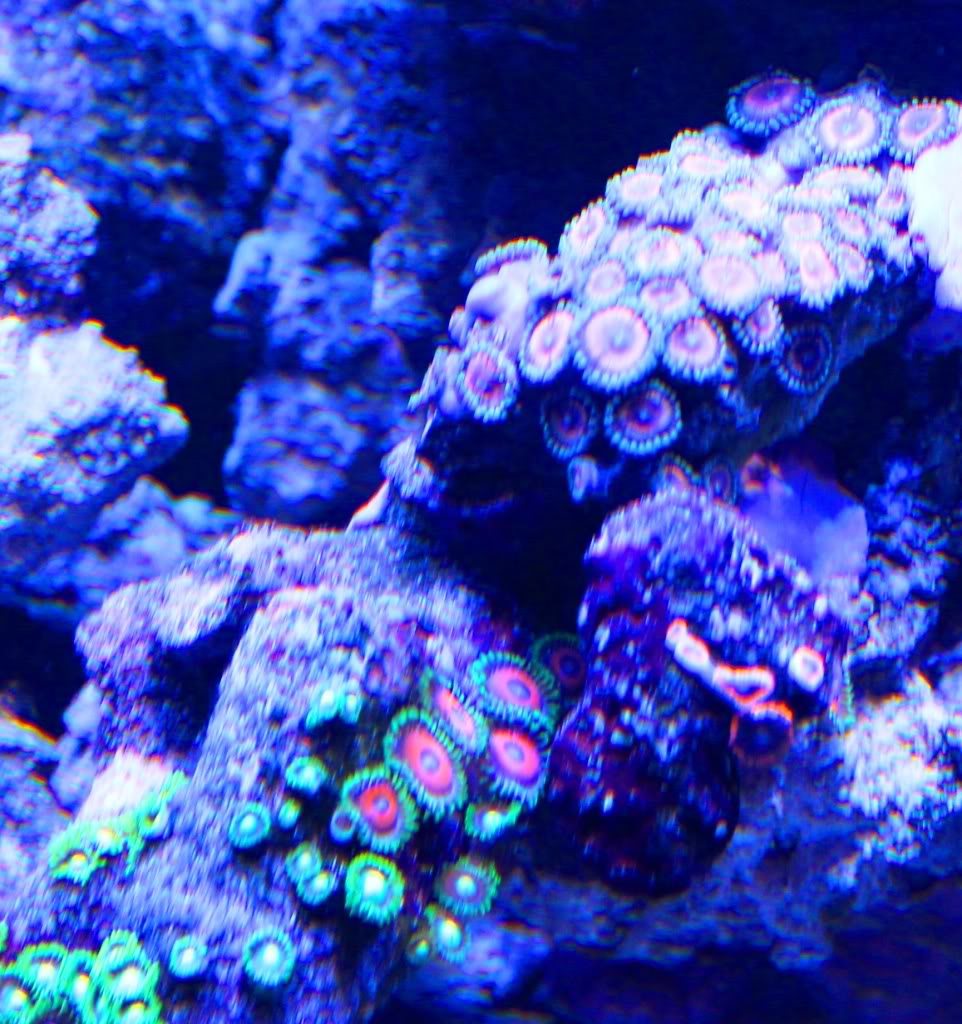



Water Conditions
The below link highlights typical water conditions zoas will require. I have had the best luck when they were kept in water with 1 to 2 ppm of nitrate when lighting and flow requirements were meat and all other water parameters in line as described in the below link. They have been known to tolerate higher levelers of nitrate for shorter periods of time.
https://www.reefaquarium.com/2013/the-basics-of-marine-aquarium-water-parameters/
General Information
Zoas are colonial type corals, meaning they form a colony of many individual polyps all connected together. As they do not have a calcified skeleton structure, they can be more tolerant of swings in the alkalinity, calcium, and magnesium when compared to other corals. However, they will not be very tolerant to swings in PH, Temp, or salinity which is no different than any other coral or fish.. This makes zoas are a very hardy soft coral placing them amount the easier to keep corals and making them an excellent choice as corals for beginners. They have also been known to grow very fast, almost like an invasive coral. Zoas are also the least aggressive when it comes to defensive abilities. They can quite frequently become damaged and even start losing heads when they fall victim to another coral’s sting or exposed to those toxins. In addition, the protective slime like coating that is on the zoas are a favorite delicacy among the “coral nipping” fish. This corals typically dies when a fish removes the outer slim coating from the coral.
As with all corals, the exterior slime coating can be a skin irritant or even highly toxic to humans so please, handle all corals with care. I would recommend wearing rubber glove whenever you handle corals
Fragging
Zoas can be easily fragged with very high success
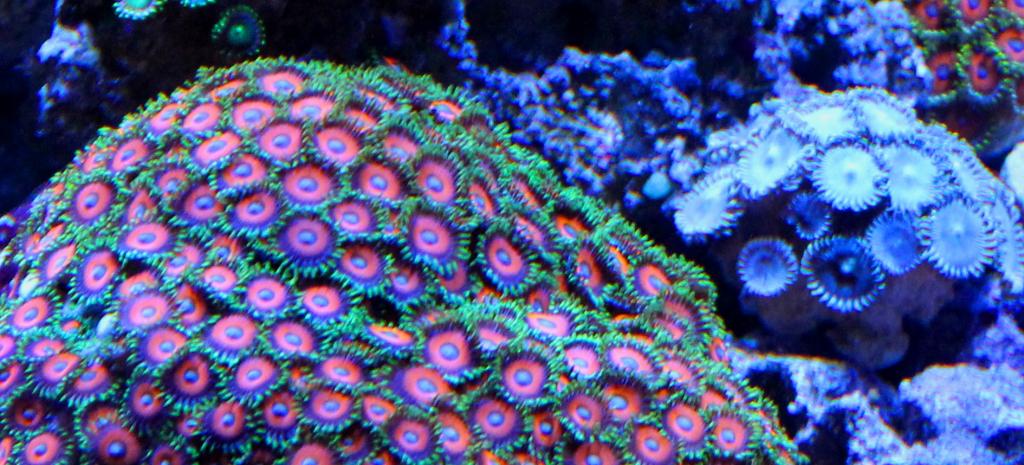
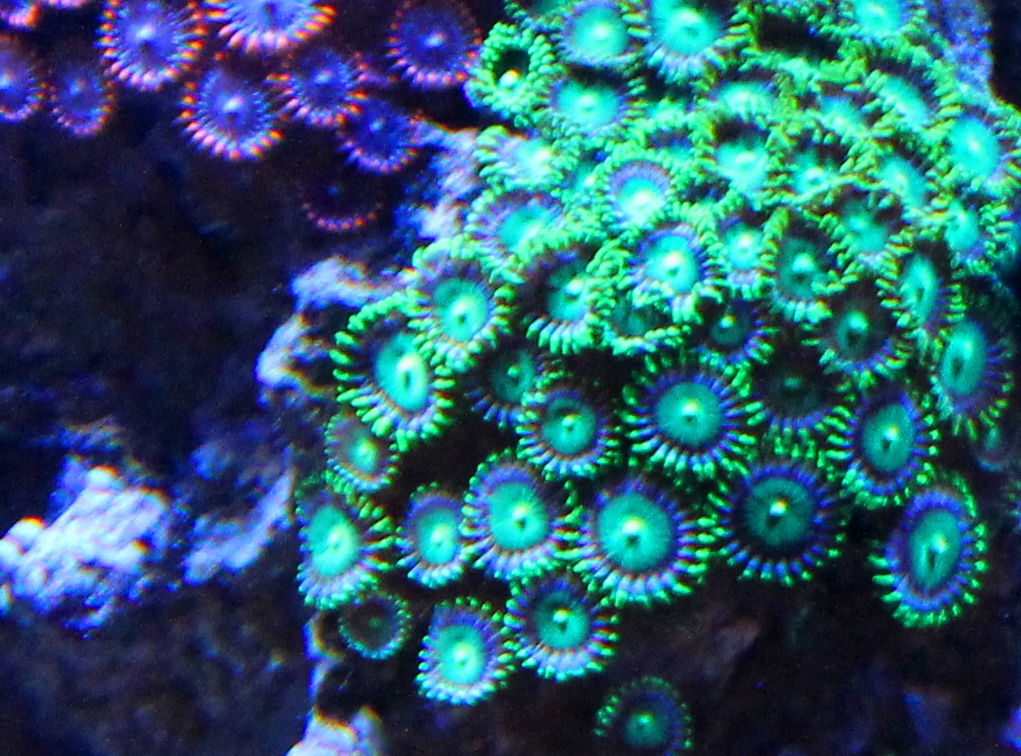
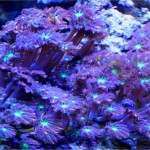
Clove Polyps
Scientific Name: Clavularia Sp
Common Name: Clove Polyps.
Type of Coral: Softie
Lighting: Moderate and Moderate to Low
Flow: Moderate and Moderate to Low
Care Level: Easy
Temperament: Peaceful
Appearance
They only get to about 2 to 3 inches in height and have a head size of about ½ to ¾ inch. These two can have slight color variations. The heads can have a bright almost neon coloring to them while the tentacles branching off the heads can have a colored line running down the center of them that may or may not have different coloring as compared to the coloring in the center of the head. In contrast, some glove polyps will only have one solid color throughout the whole coral. The heads can retract into the base of the coral making it look like a purple lumpy spot on your rocks.
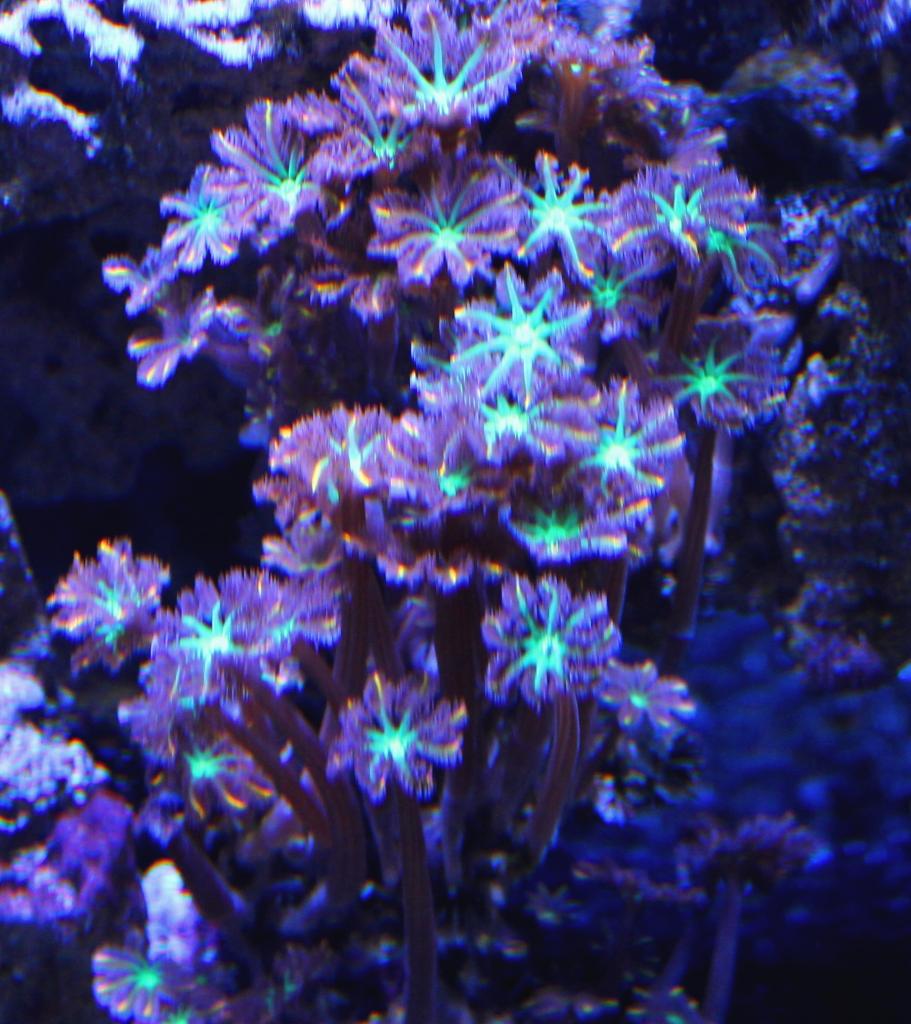
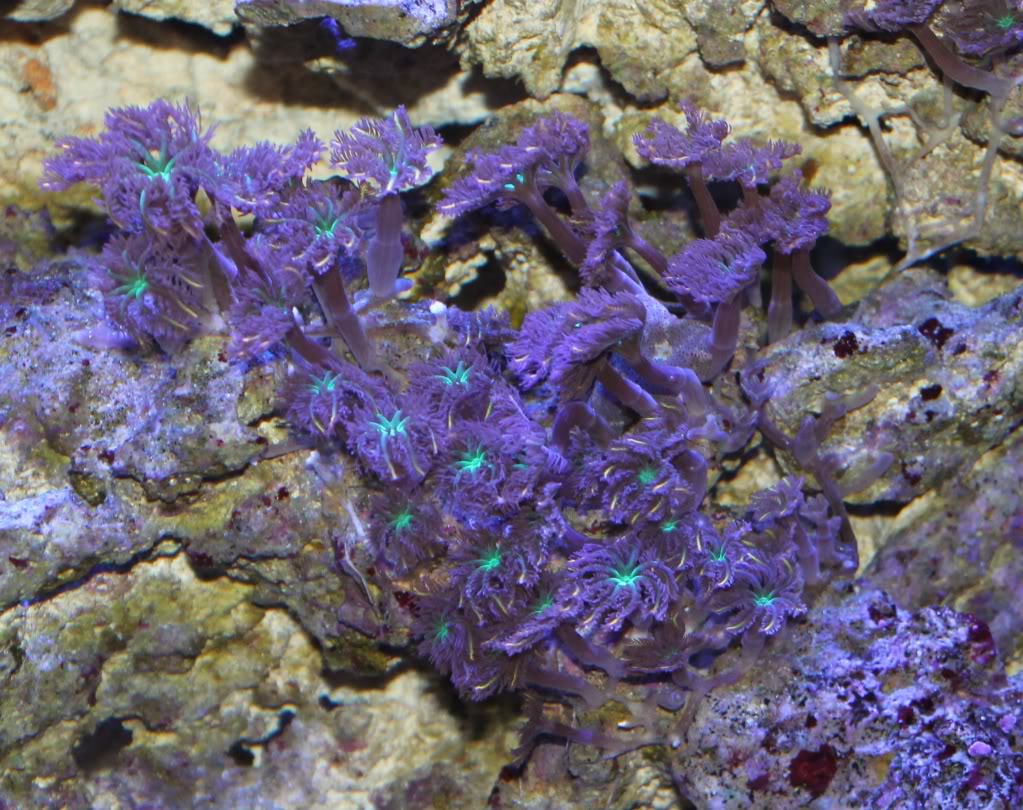
Water Conditions
The below link highlights typical water conditions clove polyps will require. I have had the best luck when they were kept in water with around 1 ppm of nitrate when lighting and flow requirements were meat and all other water parameters in line as described in the below link.
https://www.reefaquarium.com/2013/the-basics-of-marine-aquarium-water-parameters/
General Information
Clove Polyps are colonial type corals, meaning they form a colony of many individual polyps all connected together. As they do not have a calcified skeleton structure, they can be more tolerant of swings in the alkalinity, calcium, and magnesium when compared to other corals. However, they will not be very tolerant to swings in pH, Temp, or salinity which is no different than any other coral or fish..
Clove polyps are a very hardy soft coral placing them amount the easier to keep corals and making them an excellent choice as corals for beginners. They have also been known to grow very fast, almost like an invasive coral. Clove polyps are also the least aggressive when it comes to defensive abilities. They can quite frequently become damaged and even start losing heads when they fall victim to another coral’s sting or exposed to those toxins.
As with all corals, the exterior slime coating can be a skin irritant or even highly toxic to humans so please, handle all corals with care. I would recommend wearing rubber glove whenever you handle corals
Fragging
Clove polyps can be easily fragged with very high success